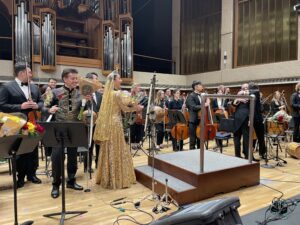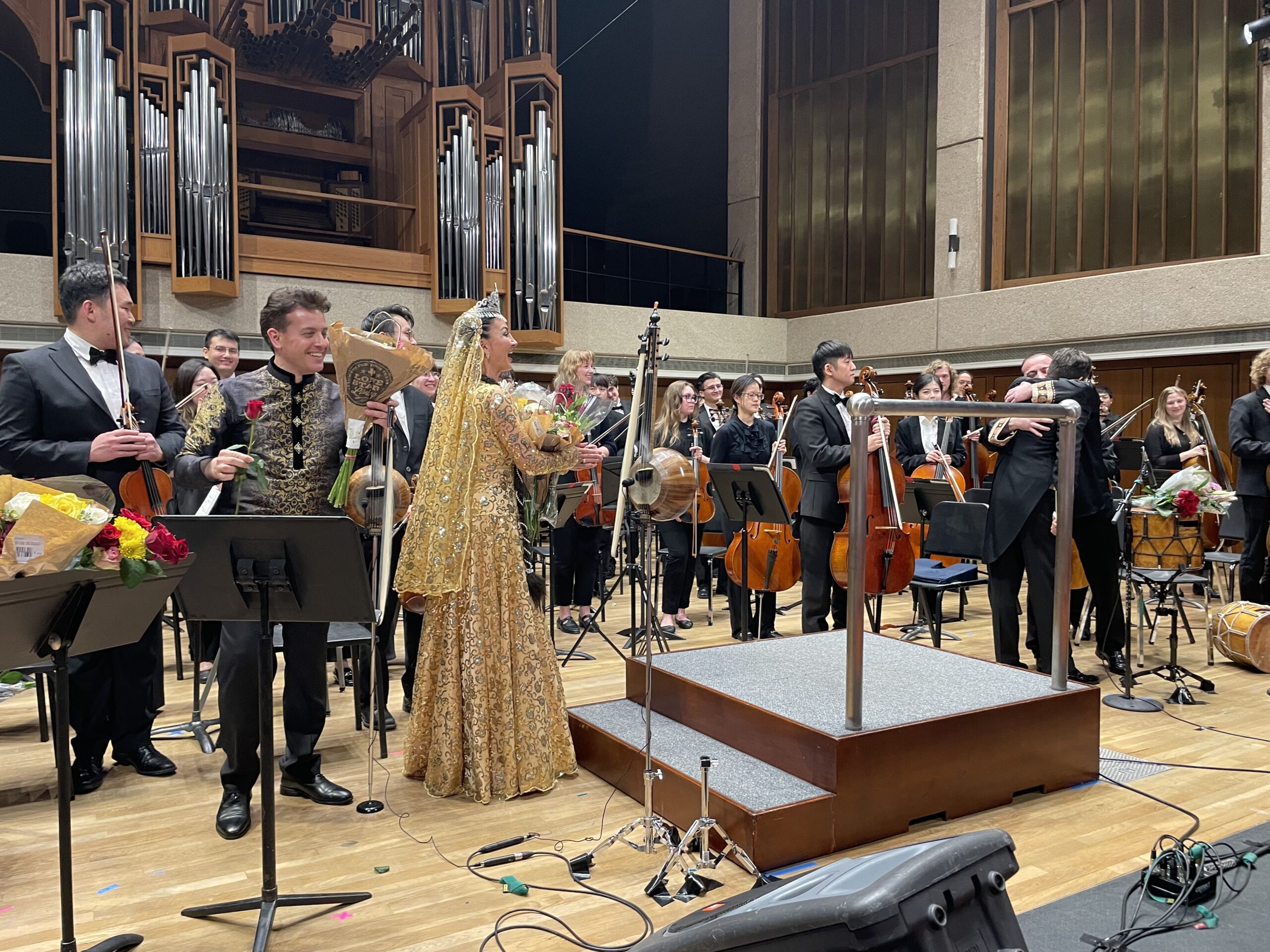The symphony orchestral performance featuring the Turkememi conductor Farhkad Hudiyev and his extraordinary guest Mugham singer Alim Hamza Qasimov, a national living treasure of Azerbaijan, was sold out on March 25. Imamyar Hasanov on kamancha, Natig Shirinov on naghara, with Laman Hendricks, dancer, and the incredible student orchestra at UT. People from around the world flew in for this once-in-a-lifetime performance.
The Sounds of Eternity, written by conductor Farhkad Hudiyev, premiered in the little-known concert hall as part of the UT campus, the Butler School of Music. The composition was dedicated to world peace and featured Hudiyev’s distinguished guests, who he invited to cross the globe for this unique and personal performance of his volution. He had to jump through legal hoops to get the musician’s visa to the USA.
Qasimov is one of the world’s foremost mugham singers. He was awarded the International Music Council-UNESCO Music Prize in 1999. According to The New York Times, “Qasimov is one of the greatest singers alive, with a searing spontaneity that conjures passion and devotion, contemplation and incantation.” He was honored with The National Medal of Glory in his home country. Mr. Gasimov has played with Yo-Yo Ma, Kronos Quartet, and other distinguished artists across the globe.
As Alim undulated the sounds from the Caucasus in Azeri, it felt like his vocal cords wandered from a lonely place until they found solace and rested his weary head in a flowery field of fragrances. Meanwhile, Hasanov’s kamancha, which sounds like a lute, flittered like birds on a feather. Once musician Natig Shirinov on naghara (percussion instrument with a thin skin) appeared, the tempo hastened like wild horses dashing through the countryside, sweeping sentiments of love, pain, wishfulness, and eternal hope against the wind.
For the first time in Texas, the mystical sounds were reminiscent of Turkish or Rumic melodies. I could see Sufi whirling dervishes dancing around. But that was just my imagination. Instead, graced by the beautiful dancer Laman Hendriks whose glittery gold dress and Asian movements – from Azerbaijan to India, felt like the calm after a thunderstorm, when tiny beads of water drip on leaves and fronds soon disappear into sunlight’s warmth.
The Sounds of Eternity echo the undercurrents of ancestry, heredity, and culture as they trickled down from Hudiyev’s birthplace to his new world home in America. The joyous ending of his composition was a celebration for the audience, musicians, and composer.
But what is Mugham music, one may ask?
Mugham is one of the many classical compositions from Azerbaijan, contrasting with tasnif and ashik. It is a highly complex art form that weds classical poetry and musical improvisation. The instruments used: are kamancha, a four-string spiked fiddle that sounds familiar to the Indian sitar, gaval, a large tambourine, and tar, which resembles a long-necked lute. These three key instruments used by Mugham developed this particular form of music throughout the centuries. Azerbaijan’s music is traceable to rock carvings on ancient monuments.
Composer and Conductor Farkhad Khudiyev wrote a poem for The Sounds of Eternity, reprinted below.
Oh, these painful songs that torment my heart…
I remember, I remember everything
Holding the hand of the beloved and hearing their last breath…
I remember, I remember everything…
Another Spring, another Sunset, another Sunrise
Oh, Life!
Oh, Creator, you taught me to love and be sincere! Oh, Creator!
This sound, this long-awaited sound…
This beautiful and familiar sound!
photo: Laman Hendriks + Conductor Hudiyev hugging naghara player Natig Shirinov

